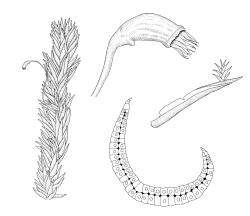Description as for Leucobryum:
Plants medium-sized to robust, pale- or white-green, forming dense cushions or tufts. Stems erect, mostly forked, in cross-section lacking (usually) or with a central strand, rhizoids usually sparse. Leaves erect, spreading, or secund, narrowly to broadly lanceolate from a ± oblong or elliptic base, rarely auriculate, ± subtubulose above, mostly acute, entire or denticulate near apex, often scabrous abaxially near apex by protruding cell ends. Lamina restricted to leaf base, consisting of 1–c. 20 rows of dead cells (hyalocysts) on either side of the costa. Alar cells not differentiated (but leaves sometimes auriculate at base). Costa broad and occupying nearly all of the leaf, at mid leaf and above consisting of a single layer of subquadrate chlorophyllose cells (chlorocysts) enclosed both abaxially and adaxially by one or more layers of large dead cells (hyalocysts) that are connected by conspicuous pores, in the alar region often with multiple layers of hyalocysts. Deciduous leaves often present at stem tips.
Pseudautoicous. Perichaetia lateral or terminal. Dwarf male plants in the tomentum or on leaves of female plants. Setae single, elongate; capsules inclined, asymmetric, sulcate when dry, often strumose; stomata none; annulus mostly lacking; operculum long-rostrate. Peristome teeth 16, lanceolate, bifid ± halfway, vertically striolate below, papillose above. Calyptra cucullate. Spores spherical.
There is little consensus on the limits of the Leucobryaceae, and the boundaries separating this family from the Dicranaceae and the Calymperaceae are particularly fluid. Regionally, neither Sainsbury (1955) nor Scott & Stone (1976) recognised the Leucobryaceae, and both included Leucobryum within their broad interpretation of the Dicranaceae. Brotherus (1924) considered it to include eight predominantly tropical genera and placed it in the order Dicranales; he divided the eight genera among four subfamilies, and this reflects the problems in its definition. Apart from Leucobryum, all the genera placed by him in the family have erect, often cylindric (but sometimes cupulate) capsules, and only Leucobryum has striate peristome tooth markings.
The Leucobryaceae has received extremely diverse circumscriptions since Brotherus’s influential treatment. Enroth (1990) described the Brotherean family concept as representing “an unnatural and artificial assemblage … which share some superficial similarities.” Enroth presented a very different view of the family, which included several additional tropical genera. Confusingly, he noted that the family name is used “in a purely descriptive sense, implying no taxonomic significance”. In the same year Eddy (1990) treated the family as monogeneric, and separated some of the genera included in the family by Enroth into their own family, the Schistomitriaceae.
Goffinet et al. (2009) and Goffinet & Buck (2020, viewed 22 Sept 2020), accepted 12 genera in the family, including the very large Campylopus, and retained it in the Dicranales. The assemblage of genera they placed in the family differs greatly, and with little explanation, from that presented by either Brotherus or Enroth. The largest genus included by them, Campylopus, lacks both the well-defined inter-cellular pores and the single layer of chlorocysts sandwiched within multiple layers of hyalocysts that are such a prominent feature of Leucobryum. Campylopus does not sit comfortably in the Leucobryaceae, and it is treated here as a member of the Dicranaceae.
A sustainable definition of the Leucobryaceae has been sought by bryologists for many decades and is outside the ambit of this Flora. The Leucobryaceae is treated here as distinct from the Dicranaceae, but to exclude the other genera placed in it by both Enroth (1990) and Goffinet & Buck (2020). The Leucobryaceae are considered here to be monotypic. Accordingly, the generic description that follows applies to the family.
| Category | Number |
|---|---|
| Indigenous (Non-endemic) | 1 |
| Total | 1 |





